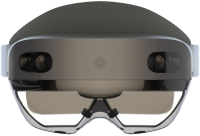This blog turns out not only to be a collection of how-to samples but also a record of my evolution as a Windows Phone 7 developer. At the end of my previous post, Safe event detachment base class for Windows Phone 7 behaviors, I promised a usage example and I decided to re-implement the behavior to show the Windows Phone 7 camera as background using the SafeBehavior as a base class. This makes the code considerable easier.
The base setup of the re-implemented behavior is pretty simple:
using System.Windows.Controls;
using System.Windows.Media;
using System.Windows.Navigation;
using Microsoft.Devices;
using Microsoft.Phone.Controls;
namespace Wp7nl.Behaviors
{
/// <summary>
/// A behavior that shows a camera view on the background of a panel
/// </summary>
public class CameraViewBackgroundBehavior : SafeBehavior<Panel>
{
private PhotoCamera camera;
private VideoBrush backgroundBrush;
public CameraViewBackgroundBehavior()
{
ListenToPageBackEvent = true;
}
}
}
Note this behavior needs to detect the user navigating back to the page – this in necessary because we need to do something with the camera.
In stead of all the song and dance for attaching and detaching events using the snippet I published earlier, it’s now a matter of overriding the OnSetup and OnCleanup methods to initialize the camera:
protected override void OnSetup()
{
if (camera == null)
{
camera = new PhotoCamera();
ParentPage.OrientationChanged += ParentPageOrientationChanged;
}
// Create a video brush with the right parameters
backgroundBrush = new VideoBrush
{
Stretch = Stretch.UniformToFill,
AlignmentX = AlignmentX.Left,
AlignmentY = AlignmentY.Top
};
// Set the video brush to the background of the panel
// and and do an initial display
AssociatedObject.Background = backgroundBrush;
backgroundBrush.SetSource(camera);
SetVideoOrientation(ParentPage.Orientation);
}
protected override void OnCleanup()
{
ParentPage.OrientationChanged -= ParentPageOrientationChanged;
camera.Dispose();
camera = null;
}
This behavior also needs to do some action when the user actually navigates back to the page, which you can do by override the OnParentPageNavigated method - in this case, re-initializing the whole behavior
/// <summary>
/// Fired whe page navigation happens
/// </summary>
/// <param name="sender"></param>
/// <param name="e"></param>
protected override void OnParentPageNavigated(object sender, NavigationEventArgs e)
{
// Re-setup when this page is navigated BACK to
if( IsNavigatingBackToBehaviorPage(e))
{
if (camera != null)
{
OnCleanup();
OnSetup();
}
}
}
The actual implementation of showing the camera background has hardly changed, and is only mentioned here for the sake of completeness:
private void ParentPageOrientationChanged(object sender, OrientationChangedEventArgs e)
{
SetVideoOrientation(e.Orientation);
}
/// <summary>
/// Sets background video brush parameters based upon page orientation
/// </summary>
/// <param name="orientation"></param>
private void SetVideoOrientation(PageOrientation orientation)
{
System.Diagnostics.Debug.WriteLine("Switching to {0}", orientation);
switch (orientation)
{
case PageOrientation.PortraitUp:
backgroundBrush.Transform =
new CompositeTransform { Rotation = 90, TranslateX = 480 };
break;
case PageOrientation.LandscapeLeft:
backgroundBrush.Transform = null;
break;
case PageOrientation.LandscapeRight:
if (Microsoft.Phone.Shell.SystemTray.IsVisible )
{
backgroundBrush.Transform =
new CompositeTransform { Rotation = 180, TranslateX = 728, TranslateY = 480 };
}
else
{
backgroundBrush.Transform =
new CompositeTransform { Rotation = 180, TranslateX = 800, TranslateY = 480 };
}
break;
}
}
As this post demonstrated, using the SafeBehavior as a base class makes life a lot easier than implementing the whole pattern over and over again, even when using a snippet.
Code is part of the the #wp7nl library on codeplex and can be found here


No comments:
Post a Comment